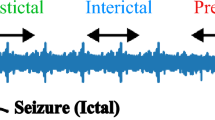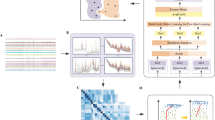Abstract
The neurological condition epilepsy is demanding and even fatal. Electroencephalogram (EEG)-based epilepsy detection still faces various difficulties. EEG readings fluctuate, and different patients have various seizure activity patterns. EEG signal detection is time-consuming and labour-intensive, which puts a strain on medical staff and raises the possibility of erroneous detections. Usually, electrodes are inserted into the scalp or inside the brain for a brief period of time in order to obtain EEG data. It is essential to research efficient cross-patient automatic epilepsy detection techniques. The multi-head self-attention mechanism recognises long-distance dependencies with the same proficiency as it does temporal dynamic correlations between short-term temporal pattern characteristics and sequential relationships. The contextual representations are inputted into a bidirectional long short-term memory network (BiLSTM) so that information can be extracted in both directions. Classification and training are carried out utilising the log SoftMax algorithm. The experiments utilised scalp EEG data from the CHB-MIT database. Sensitivity, specificity, F1-score, and accuracy were computed to be 96.5 percent, 97.04 percent, 96.6 percent, and 96.2 percent, respectively. The results of the experiment show how well the technique works for detecting seizures in several patients utilising multi-channel EEG recordings. The results also demonstrate the method's improved generalisation capabilities and resilience and consistency in collecting seizure patterns. This is particularly critical for the tertiary diagnosis of epilepsy, and the findings indicate that the proposed method significantly improves the accuracy of detection.








Similar content being viewed by others
Data availability
The data associated with this research shall be available on request.
References
Supriya S, Siuly S, Wang H, Zhang Y (2023) Epilepsy detection from EEG using complex network techniques: a review. IEEE Rev Biomed Eng 16:292–306. https://doi.org/10.1109/RBME.2021.3055956
Li J, Haldar JP, Mosher JC, Nair DR, Gonzalez-Martinez JA, Leahy RM (2019) Scalable and robust tensor decomposition of spontaneous stereotactic EEG data. IEEE Trans Biomed Eng 66(6):1549–1558. https://doi.org/10.1109/TBME.2018.2875467
Busonera G et al (2018) EEG spectral coherence analysis in nocturnal epilepsy. IEEE Trans Biomed Eng 65(12):2713–2719. https://doi.org/10.1109/TBME.2018.2814479
Xie L, Deng Z, Xu P, Choi K-S, Wang S (2019) Generalized hidden-mapping transductive transfer learning for recognition of epileptic electroencephalogram signals. IEEE Trans Cybern 49(6):2200–2214. https://doi.org/10.1109/TCYB.2018.2821764
Sheykhivand S, Rezaii TY, Mousavi Z, Delpak A, Farzamnia A (2020) Automatic identification of epileptic seizures from EEG signals using sparse representation-based classification. IEEE Access 8:138834–138845. https://doi.org/10.1109/ACCESS.2020.3011877
Fraiwan L, Alkhodari M (2020) Classification of focal and non-focal epileptic patients using single channel EEG and long short-term memory learning system. IEEE Access 8:77255–77262. https://doi.org/10.1109/ACCESS.2020.2989442
Tian X et al (2019) Deep multi-view feature learning for eeg-based epileptic seizure detection. IEEE Trans Neural Syst Rehabil Eng 27(10):1962–1972. https://doi.org/10.1109/TNSRE.2019.2940485
Rashed-Al-Mahfuz M, Moni MA, Uddin S, Alyami SA, Summers MA, Eapen V (2021) A deep convolutional neural network method to detect seizures and characteristic frequencies using Epileptic Electroencephalogram (EEG) data. In IEEE J Transl Eng Health Med 9(1–12):2000112. https://doi.org/10.1109/JTEHM.2021.3050925
Shukla U, Saxena GJ, Kumar M, Bafila AS, Pundir A, Singh S (2021) An improved decision support system for identification of abnormal EEG signals using a 1D convolutional neural network and savitzky-golay filtering. IEEE Access 9:163492–163503. https://doi.org/10.1109/ACCESS.2021.3133326
Yang Y, Truong ND, Eshraghian JK, Maher C, Nikpour A, Kavehei O (2022) A multimodal ai system for out-of-distribution generalization of seizure identification. IEEE J Biomed Health Inform 26(7):3529–3538. https://doi.org/10.1109/JBHI.2022.3157877
Khosla A, Khandnor P, Chand T (2022) Automated diagnosis of depression from EEG signals using traditional and deep learning approaches: a comparative analysis. Biocybernetics Biomed Eng 42(1):108–142. https://doi.org/10.1016/j.bbe.2021.12.005
Asadzadeh S, YousefiRezaii T, Beheshti S, Delpak A, Meshgini S (2020) A systematic review of EEG source localization techniques and their applications on diagnosis of brain abnormalities. J Neurosci Methods 339:108740. https://doi.org/10.1016/j.jneumeth.2020.108740
Kora P, Meenakshi K, Swaraja K, Rajani A, Raju MS (2021) EEG based interpretation of human brain activity during yoga and meditation using machine learning: a systematic review. Complement Ther Clin Pract 43:101329. https://doi.org/10.1016/j.ctcp.2021.101329
Babiloni C, Arakaki X, Bonanni L, Bujan A, Carrillo MC, Del Percio C, Edelmayer RM, Egan G, Elahh FM, Evans A, Ferri R, Frisoni GB, Güntekin B, Hainsworth A, Hampel H, Jelic V, Jeong J, Kim DK, Kramberger M, ... Yener G (2021) EEG measures for clinical research in major vascular cognitive impairment: Recommendations by an expert panel. Neurobiol Aging 103:78–97. https://doi.org/10.1016/j.neurobiolaging.2021.03.003
Babiloni C, Barry RJ, Başar E, Blinowska KJ, Cichocki A, Drinkenburg WH, Klimesch W, Knight RT, Lopes da Silva F, Nunez P, Oostenveld R, Jeong J, Pascual-Marqui R, Valdes-Sosa P, Hallett M (2020) International Federation of Clinical Neurophysiology (IFCN) – EEG research workgroup: recommendations on frequency and topographic analysis of resting state EEG rhythms. Part 1: applications in clinical research studies. Clin Neurophysiol 131(1):285–307. https://doi.org/10.1016/j.clinph.2019.06.234
Tremblay S, Rogasch NC, Premoli I, Blumberger DM, Casarotto S, Chen R, Di Lazzaro V, Farzan F, Ferrarelli F, Fitzgerald PB, Hui J, Ilmoniemi RJ, Kimiskidis VK, Kugiumtzis D, Lioumis P, Pascual-Leone A, Pellicciari MC, Rajji T, Thut G, ... Daskalakis ZJ (2019) Clinical utility and prospective of TMS–EEG. Clin Neurophysiol 130(5):802–844. https://doi.org/10.1016/j.clinph.2019.01.001
Mazzotti DR (2021) Landscape of biomedical informatics standards and terminologies for clinical sleep medicine research: a systematic review. Sleep Med Rev 60:101529. https://doi.org/10.1016/j.smrv.2021.101529
Sunil Kumar K, Arjun Kumar G, Gatti R, Santosh Kumar S, Bhyratae DA, Palle S (2023) Design and implementation of auto encoder based bio medical signal transmission to optimize power using convolution neural network. Neurosci Inform 3(1):100121. https://doi.org/10.1016/j.neuri.2023.100121
Shen B, Lin Y, Bi C, Zhou S, Bai Z, Zheng G, Zhou J (2019) Translational informatics for parkinson’s disease: from big biomedical data to small actionable alterations. Genomics Proteome Bioinforma 17(4):415–429. https://doi.org/10.1016/j.gpb.2018.10.007
Alhusaini S, Whelan CD, Sisodiya SM, Thompson PM (2016) Quantitative magnetic resonance imaging traits as endophenotypes for genetic mapping in epilepsy. NeuroImage: Clin 12:526–534. https://doi.org/10.1016/j.nicl.2016.09.005
Sridhar C, Bhat S, Acharya UR, Adeli H, Bairy GM (2017) Diagnosis of attention deficit hyperactivity disorder using imaging and signal processing techniques. Comput Biol Med 88:93–99. https://doi.org/10.1016/j.compbiomed.2017.07.009
Mushtaq F, Raza ZA, Batool SR, Zahid M, Onder OC, Rafique A, Nazeer MA (2022) Preparation, properties, and applications of gelatin-based hydrogels (GHs) in the environmental, technological, and biomedical sectors. Int J Biol Macromol 218:601–633. https://doi.org/10.1016/j.ijbiomac.2022.07.168
Gallotto S, Seeck M (2023) EEG biomarker candidates for the identification of epilepsy. Clin Neurophysiol Pract 8:32–41. https://doi.org/10.1016/j.cnp.2022.11.004
Peltola ME, Leitinger M, Halford JJ, Vinayan KP, Kobayashi K, Pressler RM, Mindruta I, Mayor LC, Lauronen L, Beniczky S (2023) Routine and sleep EEG: minimum recording standards of the international federation of clinical neurophysiology and the international league against epilepsy. Clin Neurophysiol 147:108–120. https://doi.org/10.1016/j.clinph.2023.01.002
Lai N, Li Z, Xu C, Wang Y, Chen Z (2023) Diverse nature of interictal oscillations: EEG-based biomarkers in epilepsy. Neurobiol Dis 177:105999. https://doi.org/10.1016/j.nbd.2023.105999
Frauscher B, Bénar C, Engel J, Grova C, Jacobs J, Kahane P, Wiebe S, Zjilmans M, Dubeau F (2023) Neurophysiology, neuropsychology, and epilepsy, in 2022: hills we have climbed and hills ahead. Neurophysiol Epilepsy Epilepsy Behav 143:109221. https://doi.org/10.1016/j.yebeh.2023.109221
Wong ZW, Engel T (2023) More than a drug target: purinergic signalling as a source for diagnostic tools in epilepsy. Neuropharmacology 222:109303. https://doi.org/10.1016/j.neuropharm.2022.109303
Jirsa V, Wang H, Triebkorn P, Hashemi M, Jha J, Gonzalez-Martinez J, Guye M, Makhalova J, Bartolomei F (2023) Personalised virtual brain models in epilepsy. Lancet Neurol 22(5):443–454. https://doi.org/10.1016/S1474-4422(23)00008-X
Norata D, Broggi S, Alvisi L, Lattanzi S, Brigo F, Tinuper P (2023) The EEG pen-on-paper sound: history and recent advances. Seizure 107:67–70. https://doi.org/10.1016/j.seizure.2023.03.011
Jiang J, Yu Y (2023) Pharmacologically targeting transient receptor potential channels for seizures and epilepsy: emerging preclinical evidence of druggability. Pharmacol Ther 244:108384. https://doi.org/10.1016/j.pharmthera.2023.108384
Smith ML, Risse G, Sziklas V, Banks S, Small D, Frasnelli J, Klein D (2023) Neurophysiology, neuropsychology, epilepsy, 2022: hills we have climbed and the hills ahead. Cognition and sensory systems in healthy and diseased subjects. Epilepsy Behav 140:109119. https://doi.org/10.1016/j.yebeh.2023.109119
Li Z, Chen L, Xu C, Chen Z, Wang Y (2023) Non-invasive sensory neuromodulation in epilepsy: updates and future perspectives. Neurobiol Dis 179:106049. https://doi.org/10.1016/j.nbd.2023.106049
Becchetti A, Grandi LC, Cerina M, Amadeo A (2023) Nicotinic acetylcholine receptors and epilepsy. Pharmacol Res 189:106698. https://doi.org/10.1016/j.phrs.2023.106698
Acknowledgements
The authors would like to acknowledge the support provided by AlMaarefa University while conducting this research.
Funding
There is no funding for this research.
Author information
Authors and Affiliations
Corresponding author
Ethics declarations
Compliance with ethical standards
There is no human or animal participation in this research.
Conflict of interest
The authors do not have any conflict of Interest.
Additional information
Publisher's Note
Springer Nature remains neutral with regard to jurisdictional claims in published maps and institutional affiliations.
Rights and permissions
Springer Nature or its licensor (e.g. a society or other partner) holds exclusive rights to this article under a publishing agreement with the author(s) or other rightsholder(s); author self-archiving of the accepted manuscript version of this article is solely governed by the terms of such publishing agreement and applicable law.
About this article
Cite this article
Dutta, A.K., Raparthi, M., Alsaadi, M. et al. Deep learning-based multi-head self-attention model for human epilepsy identification from EEG signal for biomedical traits. Multimed Tools Appl (2024). https://doi.org/10.1007/s11042-024-18918-1
Received:
Revised:
Accepted:
Published:
DOI: https://doi.org/10.1007/s11042-024-18918-1




